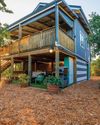
When the late explorer and crocodile hunter Jack Bousfield asked what lay in Botswana’s Makgadikgadi, he was told, “Nothing – only idiots go there.” “Fine,” he said, “that’s the place for me.”
Located beneath Chobe in the north-east part of the Kalahari Basin, the Makgadikgadi spans more than 30,000km² of dry savanna, baobab forests and the massive eponymous salt pan, a convergence of three ancient super lakes – the Sua, Nxai and Ntwetwe complexes – that began to evaporate some 10,000 years ago, leaving behind a crusty flatland the size of Switzerland. By day, it’s a shimmering sea of hardened sand, and at night, a silvery moonscape that possesses a bewitching aura, which invariably sends a hush over visitors the first time they encounter it.
For most of the year, the land lies parched, seemingly devoid of life, but as the seasonal rains begin to fall between November and March, the pans fill with water and a sensational transformation occurs. It becomes a haven for a multitude of migratory birds like the greater and lesser flamingo and countless desert-adapted creatures, including 30,000 zebra and wildebeest that traipse great distances to graze on the nutritious, mineral-rich vegetation. After the Serengeti, this is the world’s second largest terrestrial migration through one of the most important ephemeral wetlands in Africa, and it’s a magnificent sight.
Elevated view
Denne historien er fra October 2019-utgaven av Skyways.
Start din 7-dagers gratis prøveperiode på Magzter GOLD for å få tilgang til tusenvis av utvalgte premiumhistorier og 9000+ magasiner og aviser.
Allerede abonnent ? Logg på
Denne historien er fra October 2019-utgaven av Skyways.
Start din 7-dagers gratis prøveperiode på Magzter GOLD for å få tilgang til tusenvis av utvalgte premiumhistorier og 9000+ magasiner og aviser.
Allerede abonnent? Logg på

Fit For Purpose
Changing legislation offers a range of opportunities in the health sector

Good For Grinches
Finally! A holiday season Scrooge himself can invest in

A Paradise In The Wilderness
Visitors find freedom at Treedom on the Garden Route

Do It For The Kids
Parenting styles play an important role in helping children develop through the pandemic and beyond

Trekking With Teens
Travelling with adolescents comes with a unique set of challenges

Know Your Mind
Our brain uses shortcuts to think quickly but, sometimes, these mental timesavers let us down. Dr Pragya Agarwal discusses the science of cognitive biases, and why it’s more important than ever to understand how they hold sway over our views

Infected With The Travel Bug Again
As tourism-related establishments up their game to ensure visitor health and safety, it’s possible to feel positive about travelling again

Star attraction
Greater Kruger lodge makes a spectacular first impression

Palala position
The effect of the past on the present is positively felt in a luxury Waterberg lodge

Can the spam!
Irrelevant advertising will almost certainly turn consumers against your product